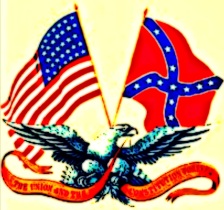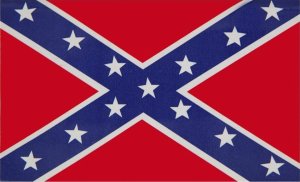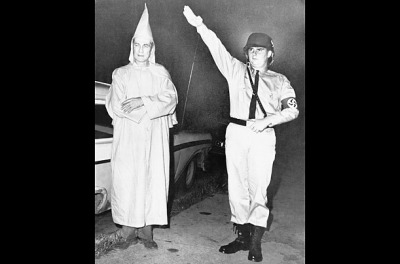 Aside from the debate still active in the public sphere about why the Civil War was fought, which the consensus of historians has long settled on as slavery, the Confederate Flag itself is a target of both adulation in the hearts and minds of one group and disgust to another. When seen, it serves as source of pride to some white Americans and profound suffering to multitudes of black Americans. Confederate imagery, as a reminder of slavery, disenfranchisement and segregation through Jim Crow laws, debt servitude (peonage) based on trumped-up charges along with convict leasing, and the typically less overt racism of today, haunts Americans just as do the sins of mass killings of Native Americans, forced internment camps for Japanese-American families in World War II and the carpet bombing of civilian jungle villages in the Vietnam War.
Aside from the debate still active in the public sphere about why the Civil War was fought, which the consensus of historians has long settled on as slavery, the Confederate Flag itself is a target of both adulation in the hearts and minds of one group and disgust to another. When seen, it serves as source of pride to some white Americans and profound suffering to multitudes of black Americans. Confederate imagery, as a reminder of slavery, disenfranchisement and segregation through Jim Crow laws, debt servitude (peonage) based on trumped-up charges along with convict leasing, and the typically less overt racism of today, haunts Americans just as do the sins of mass killings of Native Americans, forced internment camps for Japanese-American families in World War II and the carpet bombing of civilian jungle villages in the Vietnam War.
For the sake of compassion, maturity and decency, the devoted fans of the Confederate Flag could make an effort to find other symbols that represent the positive qualities of the South without the horrific baggage that comes with the traditional iconography. But, these supporters say the flag doesn’t stand for slavery or racism. For a person viewing this reasoning from the outside of this group, it’s hard to understand how these devotees could arrive at that conclusion in an honest and informed way. Or maybe they’re just selfish or deluded or unaware of how tremendous the pain and offense is for those black Americans who feel the very negative side of that flag’s history – which is fanatically strong.
I’ve written on why and how the cause for the Civil War was overwhelmingly the institution of slavery. Below, with some details on two creators of Confederate flags, we can see more evidence that the value system animating Southern states at that time was thoroughly racist and intense, given that their societal and economic structure depended on Americans believing white supremacy as irrefutably and obviously true. This Confederate axiom was, as its Vice President Alexander Stephens had said in his often referenced “Cornerstone Speech” just a few weeks before the battles begun, “the great truth that the negro is not equal to the white man; that slavery, subordination to the superior race, is his natural and normal condition.”
Notice with what deeply rooted racism the designer of what was used as the Confederate Flag between 1863 and 1865, William Tappan Thompson, said motivated his new sketch and idea, even in the colors chosen particularly and symbolically. It was called “The Stainless Banner” officially and “The White Man’s Flag” specifically by Thompson.

The quote below includes content from three of his articles published during April-May, 1863, in the Savannah Morning News, where he was the editor:
“As a people, we are fighting to maintain the Heaven-ordained supremacy of the white man over the inferior or colored race; a white flag would thus be emblematical of our cause…Such a flag…would soon take rank among the proudest ensigns of the nations, and be hailed by the civilized world as THE WHITE MAN’S FLAG…As a national emblem, it is significant of our higher cause, the cause of a superior race, and a higher civilization contending against ignorance, infidelity, and barbarism.”
After the war, he advocated with great fervor against voting rights for blacks.
William Porcher Miles designed The Battle Flag of the Army of Northern Virginia, the emblem marched into warfare with the soldiers under the command of Robert E. Lee. This flag eventually became associated with the Confederacy as a whole when the fighting formally stopped.
Miles, right in line with other proponents of Confederate values, claimed that slavery was a “divine institution” and that men are “born neither free nor equal”. He was a member of the Fire-Eaters, a Southern activist group that exercised great influence in pushing for war over the right to maintain a society based on the ownership of non-white human beings. They further appealed to their fellow Southerners to reopen the international slave trade.
Right after the war ended and onward, this flag was displayed at reunions of Confederate army veterans. Much later, it was used by segregationists in the 1950s-1960s. It represented a Confederate nation overtly based on the separation of the races, one of which was allegedly inferior by nature.
Why is it that many conservatives who want to say that they are pursuing true patriotism in how they live their lives make up the demographic in which the vast majority of admirers of the Confederacy reside? How can this logically and genuinely not be called a treasonous mindset? Honoring a group of people from the 1800s who began an epic conflict with the worst death toll in U.S. history? That was pursued so that hatred and exploitation of another race could be maintained?
Though the North had plenty of racism throughout the 1800s, they had moved progressively away from legal slavery in their states many decades before the Civil War. Vermont was the first state to abolish slavery in 1777. The last of the Northern states made it illegal in 1804. However, as PBS notes in a special series on slavery in America:
“In most of these states…abolition was not immediate. Instead, gradual emancipation laws set deadlines by which all slaves would be freed, releasing individuals as they reached a certain age or the end of a certain work period. This situation left some African Americans lingering in bonded servitude. Pennsylvania passed its Act for the Gradual Abolition of Slavery in 1780. Yet, as late as 1850, the federal census recorded that there were still hundreds of young blacks in Pennsylvania, who would remain enslaved until their 28th birthdays.”
Here is one of the central meanings of the various flags of the Confederacy: rebellion against the government. They were made to stand for a set of beliefs and behaviors established by men in the 1860s and these values and histories are alive with those images. There are too many deeply negative actions from the past associated with those emblems that make it impossible to be a symbol of heritage for most Americans. In fact, it would be very unusual for other countries to allow their provinces to have a flag that represents division and civil war. Nazi Germany is a comparative example often spoken about and though there are many differences between the two societies, they share a barbarism and methodical racism of the highest commitment. Both countries used segregation, bullying, abuse, rape, torture and murder to maintain the desired social order. Since the non-white races, whether Jews or blacks, were considered discardable and without inherent dignity, they could be treated however a Confederate or Nazi German decided and so there would be no consequence or punishment for the perpetrator. The Confederacy did not attempt a full scale extermination as did the Nazis, but that would have been radically counterproductive since they were completely dependent on blacks to perform the South’s massive labor needs. Slavery was the engine of the Confederate economy. Both societies followed nonsensical ideologies based in falsehoods, yet these beliefs were convenient for those individuals and people groups in power.
Largely because of their pro-British stance that had lasted for many generations, American Southerners in the 1930s very much despised the Nazis. There was much affection the other way around, however. Regardless, both groups behaved in a similar manner. As an example of the commonalities in their worldviews, see these 2013 comments from the London Review of Books about Fear Itself: The New Deal and the Origins of Our Time by Ira Katznelson:
“In a debate on anti-lynching legislation in the US Senate in 1938, the senator from Mississippi Theodore Bilbo echoed Mein Kampf in asserting that merely ‘one drop of Negro blood placed in the veins of the purest Caucasian destroys the inventive genius of his mind and strikes palsied his creative faculties.’ The elected representatives of the South successfully blocked any legislative attempt to clamp down on lynching, holding it to be a matter for individual states to regulate, and something that Northerners couldn’t understand. Only Southerners knew what was at stake. Bilbo suspected a Jewish conspiracy behind what he saw as Northern interference: ‘The niggers and Jews of New York are working hand in hand.’ During Roosevelt’s first two terms, lynching continued unabated. There were 28 recorded instances in 1933 alone, the first year of the New Deal. This tacit acceptance of extra-legal killing was something else that struck a chord with the Nazis. In fact, what happened in the South was in the early 1930s more overt and more bestial than anything taking place in Germany, where state-sanctioned murder was treated as an unpleasant necessity rather than a public festival. As Ira Katznelson records, in November 1933, more than a year after FDR’s election, Lloyd Warner was burned alive before a cheering crowd of ten thousand in Princess Anne, Maryland, after an attempt to hang him had failed. Nothing so ghastly was permitted on the streets of Hitler’s new Reich. Still, this didn’t stop the Nazis romanticising the South and indulging in soft-soap fantasies about its martial culture. The German edition of Gone with the Wind – Vom Winde verweht – fascinated Hitler when it appeared in 1937. The film too was a big hit with the Nazi elite. On 22 June 1941, while he was waiting for the launch of Operation Barbarossa, Goebbels spent the hours after midnight watching a pre-release of the German version. It was comfort viewing….The Montgomery Advertiser, taking note in 1933 of the regime’s attacks on Jews, apparently perceived no irony in declaring that ‘Hitler will only gain respect in the US if he stops persecuting the minority.’ The same newspapers flatly rejected any attempt to compare lynching to the systematic persecutions carried out by the Nazis. The point about lynching was that it remained ostensibly illegal, whereas Hitler was using the instruments of the law to pursue his campaigns of violence.”
One major contrast is that in 21st century Germany there is a huge amount of shame related to that era of Nazi rule and the hated flag has been banned. In America, there is a mental disconnect among many people regarding the rebellion that led to more than 600,000 deaths and an image that somehow purely represents Southern heritage. What heritage are we supposed to interpret from seeing this flag waiving next to Old Glory? When is the last time anyone saw the flag of a European country waiving next to the flag of a former colony’s flag at the latter’s capitol building? Different and intentionally separate governments. One oppressed the other. Many times a war was involved. There’s only room for one government in a nation and it makes no sense to include a defeated enemy symbol on public property, especially when that design was used by a civilization founded and intricately dependent on racist principles.
There are many positive characteristics about the South and its history. But, the Confederate flag is so toxic that as long as it remains part of the Southern cultural landscape in a place of honor through support from a significant number of people, the world will be distracted away from those good qualities.








There were hundreds of thousands of white slaves, called indentured servants, here before there were black slaves. Free blacks in the US knew of slavery in Africa and the Middle East. The first black slave was owned by a free black. By 1830, according to census records, 30% of free blacks in the US owned black slaves while 1.8% of whites did. Three thousand of these free black slave owners lived in New Orleans. Many had brought family members to be slaves as living conditions here were better as a slave than in Africa as a free man. Slavery was purely and simply a financial decision by folks, black and white, to have labor to work their land or a personal servant. There are proud pictures of free black soldiers that fought to preserve the Confederacy standing next to the Confederate flag.
History is history and should not be warped to make it say whatever one would like it to say.
History, after all, should be studies for it’s lessons and not distorted to promote actions or beliefs.
LikeLike
Hi Don.
No one can honestly deny the prevalence of slavery throughout history.
I don’t see how what you wrote relates to the article above. Slavery is unethical, whether because of race, economics or both. The Confederacy made it very clear that their worldview and economy was based on white supremacy and slavery together. This racism and social structure has changed very slowly since the Civil War – often only because the federal government had to force the states (Northern and Southern) to change their ways:
https://en.m.wikipedia.org/wiki/List_of_Jim_Crow_law_examples_by_state
In the article below, I include the famous documentation clearly showing the constitutions of each Confederate state and the proclaimed agenda of the CSA itself as being overtly based on proud “divinely inspired and ordained” white supremacism:
https://persuademepolitics.wordpress.com/2016/03/23/was-the-civil-war-fought-primarily-over-slavery
You seem to be saying that my article is rewriting history to suit my own beliefs or ends. How is that the case when what is presented there fits with the perspective of the overwhelming majority of historians?
Lastly, please provide reference links or info for each of the stats you included in your comment.
Thanks.
LikeLike